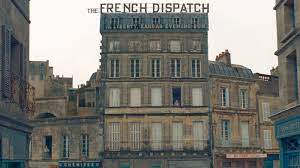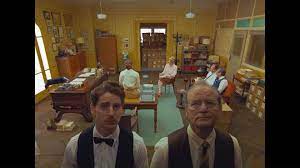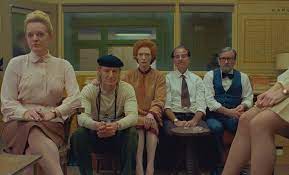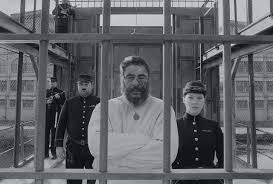
Apart from Spike
Lee and David Fincher, very few contemporary American film
directors can claim to have earned the title of
auteur, but for sheer visual invention and cinematic
joie de vivre, there is no more consistent director
working in Hollywood today than Wes Anderson. His movies are
immediately identifiable by their ensemble casting,
extravagant visual mannerisms, and hectic pace. The release
of his tenth feature film was delayed by a year due to COVID
and much has been made of the nine-minute standing ovation
it received at the Cannes Film Festival, but the prolonged
applause was for the onstage antics of the actors and
director, so it's misleading to claim it was for the movie
itself. Nonetheless, The French Dispatch doubles down
on Anderson's trademark style, including sonorous voiceovers
that undercut the on-screen action, highly symmetrical,
rectilinear compositions, and a frothy, light-hearted sense
of humour. It is a brilliant, star-filled,
portmanteau picture that takes as its jumping-off
point the final issue of a supplement magazine for the
fictional Liberty, Kansas Evening Sun newspaper.
The French Dispatch is simultaneously a sustained riff on and tribute to the New Yorker magazine's typographical layout and subtle, understated cartoons. It combines the same sort of metropolitan sophistication targeted at a general American readership with elegant and eccentric invention, laced with a heady mix of upbeat buoyancy, originality, and moment-by-moment strokes of pure genius. A February 2020 New Yorker article outlined some of the characters, subjects, and situations depicted by Anderson, along with the corresponding articles, subjects, and writers. These include Arthur Howitzer, Jr. (an amalgam of the New Yorker's founding editor Ross and the late Robert B Silvers of the New York Review of Books), Herbsaint Sazerac (inspired by writer Joseph Mitchell), and Julian Cadazio (inspired by Lord Duveen, subject of a 1951 six-part New Yorker profile by SN Berman). The character of food writer Roebuck Wright is based on James Baldwin and AJ Liebling, both regular New Yorker contributors over the years. Lucinda Krementz closely resembles Mavis Gallant, who wrote a two-part 1968 piece on the student uprisings in France, and shares her last name with Jill Krementz, the widow of author Kurt Vonnegut Jr. and a photographer whose work often appeared in the New Yorker.
The French Dispatch itself is a special feuilleton-type guide to French intellectual life produced in the magazine’s late sixties heyday by a gallery of brilliant American expatriates in the imaginary provincial French town of Ennui-Sur-Blasé. The joke here is that both ennui and blasé mean roughly the same thing - a sophisticated and world-weary boredom with the world. French place names often contain the word 'sur' ('upon') as a geographic descriptor, so if it were a real place name Ennui-sur-Blasé would roughly translate as "Boredom-upon-Apathy."
The movie is full of equally cute and delightful Francophone puns, cultural references, and cinematic hat-tips. The café where a group of dissident students hang out is called 'Le Sans Blague,' which means 'no kidding' or 'no joke.' The chairs and tables were sourced by set decorator Rena DeAngelo from a prop house called Les 2 Ailleurs, while she had the coffee cups made in Limoges, a city famous for its porcelain. To communicate how he wanted this part to look, Anderson sent the cast reference material which included such French New Wave films as François Truffaut's The 400 Blows and Jean-Luc Godard's Breathless and Weekend.
The character of Herbsaint Sazerac was named after an anise-flavored liqueur, while Sazerac is a brand of rye whiskey (combined together, they form a cocktail also called a 'Sazerac'). The police commissioner's chef, Nescaffier, is homonymically named for the ground coffee products brand, Nescafé, while the scene in which the waiter climbs the stairs in the editor's house is an homage to the opening scene in Jaques Tati's Mon Oncle. In a 2019 interview for Konbini, Mathieu Amalric revealed that his character was inspired by Henri-Georges Clouzot's Quai des Orfèvres (1947) and that Anderson asked him to watch the movie in preparation for the part.
The narrative structure of the movie is that of a short story anthology set in a sort of post-modern Clochemerle and is based on the long-read reportage of its superstar writers, who all have some personal and/or sexual involvement with their subjects, contrary to any inhibiting concepts about journalistic neutrality. It is made up of three discrete stories, each based on a separate feature article, plus a brief, scene-setting travelogue that digs into the insalubrious nooks and crannies of Ennui-sur-Blasé, and a final obituary section. An extraordinary cast enlivens all three narrative arcs, featuring an insane artist, a student protest, and a heist thriller.

The proprietor and
editor of The French Dispatch is the diffident, avuncular,
yet highly authoritative Howitzer, played by Bill Murray as
a cold and stern taskmaster who fires a copy boy for
presuming to tell him the print deadline is approaching.
Howitzer has only two journalistic maxims - “no crying”
and “try to make it seem you wrote it that way on
purpose.” These are also Anderson’s creative dictums - a
lack of sentimentality combined with due diligence and
intense deliberation. The only hint of nostalgia for a lost
age or a bygone era comes with the end credits that exude a
sweetly elegiac tone of melancholy, as the magazine finally
folds and we are invited to mourn the end of a non-existent
publication. Created by Spanish illustrator Javi Aznarez in
the New Yorker's inimitable style, one image depicts
a set table with a wine glass, cutlery, and a revolver with
a knife attached to the bottom of the barrel. A similar
contraption was also briefly featured in a 2006 American
Express commercial starring Anderson, in which he asks his
production armorer to make a ".357 with a bayonet." The
armorer returns shortly with a sketch of a revolver with a
bayonet attached to the bottom of the barrel, which Anderson
immediately approves.
The stellar cast includes seven Oscar winners (McDormand, Swinton, Del Toro, Chritsoph Waltz, Adrien Brody, Anjelica Huston, and Fisher Stevens) and nine Oscar nominees (Murray, Chalamet, Saoirse Ronan, Willem Dafoe, Edward Norton, Griffin Dune, Owen Wilson, Bruno Delbonnel, and Bob Balaban). Collectively, the cast has won a total of eleven Oscars, while the crew has won eight (McDormand has four, Christoph Waltz has two, while Fisher Stevens, Anjelica Huston, Benicio Del Toro, Tilda Swinton and Adrien Brody have one each). Costume designer Milena Canonero has won four, composer Alexandre Desplat has won two, while production designer Adam Stockhausen and hair and makeup designer Frances Hannon have one won, including Oscars for The Grand Budapest Hotel. Despite garnering seven nominations himself, Wes Anderson has never won an Oscar.

Tilda Swinton plays
art critic JKL Berensen, who tells the story of convicted
murderer Moses Rosenthaler (Benicio Del Toro), whose
stunningly beautiful prison warden Simone (Léa Seydoux)
acts as nude model and muse. Frances McDormand is Krementz,
an ace reporter who dives into Ennui-Sur-Blasé’s roiling
student revolutionary scene and has an affair with its
hirsute, chess-playing, charismatic leader Zeffirelli
(Timothée Chalamet). Jeffrey Wright somehow manages to
channel both Baldwin and Orson Welles simultaneously,
providing a mellifluent and poised performance as Roebuck
Wright, whose job is to provide special meals for les
flics and who provides an eyewitness account of the
kidnapping of the Commissaire's son (Mathieu Amalric). The
vast repertory cast includes many other big names in small
cameo roles, many of whom have suggested that this was the
most exhilarating and challenging fun they had ever
experienced on a movie set, since every scene included as
much improvisation as possible, but also provided a deftly
constructed screenplay upon which to fall back.
The intricately layered details and fanatically meticulous design of Anderson's films invariably reward a second viewing and The French Dispatch is no exception, but the problem with the anthology structure is its inevitable unevenness. However amusing the film’s final segment may be, the audience's patience may be tested by the preceding tale of student protest. When casting Chalamet (the role was written specifically for him), Anderson told GQ magazine, "I never had the inconvenience of ever thinking of anybody else for this role even for a second.” It says a lot about about his hermetically sealed sense of privilege that Anderson can take something as essential as civil dissent and render it in a tonal palette of pale pastels, while neatly sidestepping any hint of real political engagement.

The first section,
however, featuring a criminally insane artist played by Del
Toro, is a sly pleasure, not least because it is narrated by
an almost unrecognisable Tilda Swinton as a fabulously
glamorous arts correspondent, replete with buck teeth, a
tangerine evening dress, and the tantalising hint of a
scandalous past. The travelogue, a bike ride to the dark
side starring Owen Wilson that includes pickpockets,
floating corpses, and bands of renegade choirboys (“drunk
on the blood of Christ,” has a bracing savagery somewhat
at odds with the film’s otherwise self-consciously
charming aesthetic. Anderson’s sort of steroid-boosted
Gallicism is reminiscent of recent films such as
Belleville Rendez-Vous and Amélie, undeniably
lovely and highly appealing, but about as far removed from
reality as his romanticised portrayal of a bygone journalist
era.
In a fascinating Archtectural Digest article by Rachel Wallace, production designer Adam Stockhausen and set decorator Rena DeAngelo described how they transformed the French town of Angoulême, where the topography and architecture was camera-ready to stand in for the quirky town of Ennui-sur-Blase. Stockhausen and his team first embarked on what he termed “Google scouting,” to find the perfect location - “We just sort of go to Google Maps and drop the little yellow guy and start walking the streets and looking around. We looked all over and then kind of started to narrow that down into a list of different towns that looked promising.” Scouts were then sent to take pictures and Anderson eventually settled on Angoulême, a city famous for its annual comic book festival. “There’s this road that wraps around, and around, and around as it goes [uphill],” said Stockhausen, “and then these roads that crisscross that. It makes for these really incredible nooks and crannies and twists and turns, which Wes was exploiting constantly.”
Swinton’s real-life partner Sandro Kopp created Rosenthaler’s abstract paintings, including a series of large frescoes on the prison walls. Kopp described the experience as “the most challenging and also the most satisfying thing I have done in my life so far. I arrived in Angoulême knowing that I had two-and-a-half months to create ten massive paintings that had to look like a genius had worked on them for three years.” Pieces of local culture also made it into the prison scenery - artisanal pottery was used as props for an inmate art class and the prisoners pad around in the felt slippers, or Charentaises, traditionally made in the area. “We have a bit of a history of finding a nontraditional space to build sets and to work in,” Stockhausen said, noting that when he worked on Moonrise Kingdom, they built the sets inside a former Linens N' Things in a Rhode Island strip mall - “I think that the process of designing the film [was] so much about puzzle solving and trying to figure out how to make something from nothing.”
Anderson grew up making silent films on his father's Super-8 camera which starred his brothers and friends, although his first ambition was to be a writer. He graduated from St. John's School in Houston in 1987, which he later used as a prominent location throughout Rushmore (1988). He worked part-time as a projectionist while attending the University of Texas at Austin, where he met his roommate and future collaborator Owen Wilson. In 1991 he graduated with a BA in philosophy.
Anderson's first film was Bottle Rocket (1996), a crime caper about a group of young Texans aspiring to achieve major heists. It was well reviewed, but performed poorly at the box office. This was followed by Rushmore, a quirky comedy about a high school student's crush on an elementary school teacher that starred Bill Murray and was a critical and financial success. It launched Murray's second act as a respected actor and he has since appeared in every Anderson film to date. Martin Scorsese has praised both Bottle Rocket and Rushmore, which was selected for preservation in the United States National Film Registry by the Library of Congress for being "culturally, historically, or aesthetically significant." Andersen's next comedy-drama, The Royal Tenenbaum's (2001), focused on a successful and artistic New York City family and its ostracized patriarch played by Gene Hackman. It was a critical success and his most profitable movie until Moonrise Kingdom (earning more than $50 million in domestic box-office receipts), was nominated for an Oscar, and ranked by an Empire poll as the 159th greatest film ever made.
The Life Aquatic with Steve Zissou (2004) revolved around a Jacques Cousteau-type documentary filmmaker, also played by Murray. The film was a classic example of Anderson's hyperkinetic style, but its critical reception was less favorable than his previous films and its box office failed to match The Royal Tenenbaums. In 2006, Steely Dan's Walter Becker and Donald Fagen released a tongue-in-cheek "letter of intervention" for Anderson's artistic "malaise," following the disappointing reception of The Life Aquatic with Steve Zissou, and offered him their soundtrack services for his next feature, including lyrics for a title track.
The Darjeeling Limited (2007) was about three emotionally distant brothers traveling together on a train in India. It reflected the more dramatic tone of The Royal Tenenbaums, but faced criticisms similar to The Life Aquatic with Steve Zissou. Anderson has acknowledged that he went to India to film the movie partly as a tribute to Indian filmmaker Satyajit Ray, whose "films have also inspired all my other movies in different ways" (the film is dedicated to him). Two years later, Anderson's stop-motion animated film Fantastic Mr Fox, based on the Roald Dahl short story, was released. Although it barely made back its production budget, it was highly praised among critics and nominated for Best Animated Feature.
In 2012, Moonrise Kingdom debuted at Cannes, where it competed for the Palme d'Or. A coming-of-age comedy set in a fictional New England town, it concerned two children who run away together and the effect their disappearance has on their their families and the small town community in which they live. It was a financial success, earning $68.3 million, against a budget of only $16 million. Anderson's next film, The Grand Budapest Hotel (2014), starred Ralph Fiennes and was set mostly in the 1930s. It followed the adventures of the hotel's meticulous concierge and made "a marvelous mockery of history, turning its horrors into a series of graceful jokes and mischievous gestures," according to the New York Times. It grossed nearly $175 million worldwide and earned dozens of award nominations, including nine Oscar nominations and four wins.
Anderson's absurd sense of humour and penchant for ensemble acting are clearly inspired by many influences - Orson Welles, John Huston, Ernst Lubitsch, Jean Renoir, François Truffaut, Satyajit Ray, Robert Atman, Mike Nichols, Hal Ashby, Stanly Kubrick, and Woody Allen to name but a few. From The Life Aquatic with Steve Zissou onward, Anderson has also utilised animation and miniatures, even making entire features with stop-motion animation (Fantastic Mr. Fox and Isle of Dogs). He is noted for extensive use of flat space camera moves, symmetrical compositions, snap-zooms, slow-motion walking shots, a deliberately limited color palette, hand-made art direction (often utilizing miniatures), and 'knolling' - a term first used in 1987 by Andrew Kromelow, a janitor at Frank Gehry's furniture fabrication shop. At the time, Gehry was designing chairs for Knoll, known for Florence Knoll's angular furniture. Kromelow would arrange any displaced tools at right angles on all surfaces, and called this routine 'knolling,' because the tools were all arranged in right angles, similar to Knoll furniture. The result was an organized surface that allowed the user to see all objects at once, which is precisely Anderson's preferred approach to on-screen action and composition within the frame.
These stylistic choices give his movies a distinctively wry and whimsical flavour that has provoked much critical discussion, mash-ups, and parodies. Many critics (and even Anderson himself) have commented that they give his films the feel of being self-contained worlds or scale-model doll's houses. According to Jesse Fox Mayshark, they have "a baroque pop bent that is not realist, surrealist or magic realist," but might best be described as "fabul[ist]". They are each uniquely complex, rapid-fire movies, drenched in dry humour, visual invention, and bucketloads of cinematic panache. Maybe next year Anderson will finally be rewarded with that elusive Oscar he so clearly deserves.



 Emirates Team NZ: Statement From Emirates Team NZ On Auckland Hosting Of 38th America’s Cup
Emirates Team NZ: Statement From Emirates Team NZ On Auckland Hosting Of 38th America’s Cup PPTA Te Wehengarua: Draft English Curriculum Lacks Connection With Reality
PPTA Te Wehengarua: Draft English Curriculum Lacks Connection With Reality Oratia Books: Revised Edition Of Much-praised History Examines The Great War Experience Of New Zealand, Australia And Canada
Oratia Books: Revised Edition Of Much-praised History Examines The Great War Experience Of New Zealand, Australia And Canada Brain Injury NZ: Creating Solutions - ID Card For People With Brain Injury Launched
Brain Injury NZ: Creating Solutions - ID Card For People With Brain Injury Launched University of Auckland: AI Leads To Breakthrough In Knee Surgery
University of Auckland: AI Leads To Breakthrough In Knee Surgery The Label: Independent Music NZ Announces Taite Music Prize IMNZ Classic Record 2025
The Label: Independent Music NZ Announces Taite Music Prize IMNZ Classic Record 2025